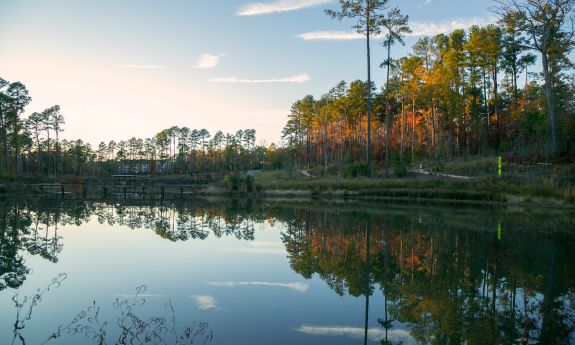Duke Pond to Undergo Essential Maintenance
Water level of the pond will be lowered beginning in early November

“When you collect so much stormwater from campus, you inevitably get a whole bunch of sediment and debris with it,” said Duke University Landscape Architect Mark Hough, who helped design the pond situated on a 12-acre site near Circuit Drive and Towerview Road. “We knew going into it that this would be part of the process.”

Since the pond opened, the area closest to Circuit Drive – designed to be a sediment-catching feature called a “forebay” – has accumulated roughly 1,300 cubic yards of sludge that has raised the level of pond floor several feet.
“The function of the forebay is to capture that sedimentation before it gets into the main pond,” said Duke Facilities Management Civil Engineer Ryan Lavinder. “By design, it needs to be drained.”
The draining of the pond will begin when valves are opened in a 14-foot-tall concrete structure called a “riser” that juts up from the bottom of the pond.
Once much of the pond is drained, workers will remove the sediment from the forebay, a process that could take roughly a month. The forebay will be fenced off during the work. After the forebay is cleared, which is expected to be around the start of 2025, the valves in the riser will be closed and the water will return to the pond. The process of refilling the pond will be done by natural rainfall.
While the sediment removal project is unfolding, additional work around the pond will be completed, such as repaving the walking trail and adding approximately 25,000 aquatic plants – such as spikerush, pickerelweed and yellow pond lilies – to the shoreline.
Opened in 2015, the pond has won multiple awards for its design and function. It’s been a success as a water reclamation tool by saving Duke around 100 million gallons of water per year by supplying water for the cooling towers of Duke’s nearby Chilled Water Plant No. 2. And it’s become a popular walking spot on campus.
“When you go into something like this, it’s the dynamism and the ephemerality that make it exciting,” Hough said about the pond. “You build it and nature is going to do what nature does. In a lot of ways you just have to sit back and watch it and then adjust as you can with anything that’s unwanted.”
Send story ideas, shout-outs and photographs through our story idea form or write working@duke.edu.
Follow Working@Duke on X (Twitter), Facebook and Instagram and subscribe on YouTube.